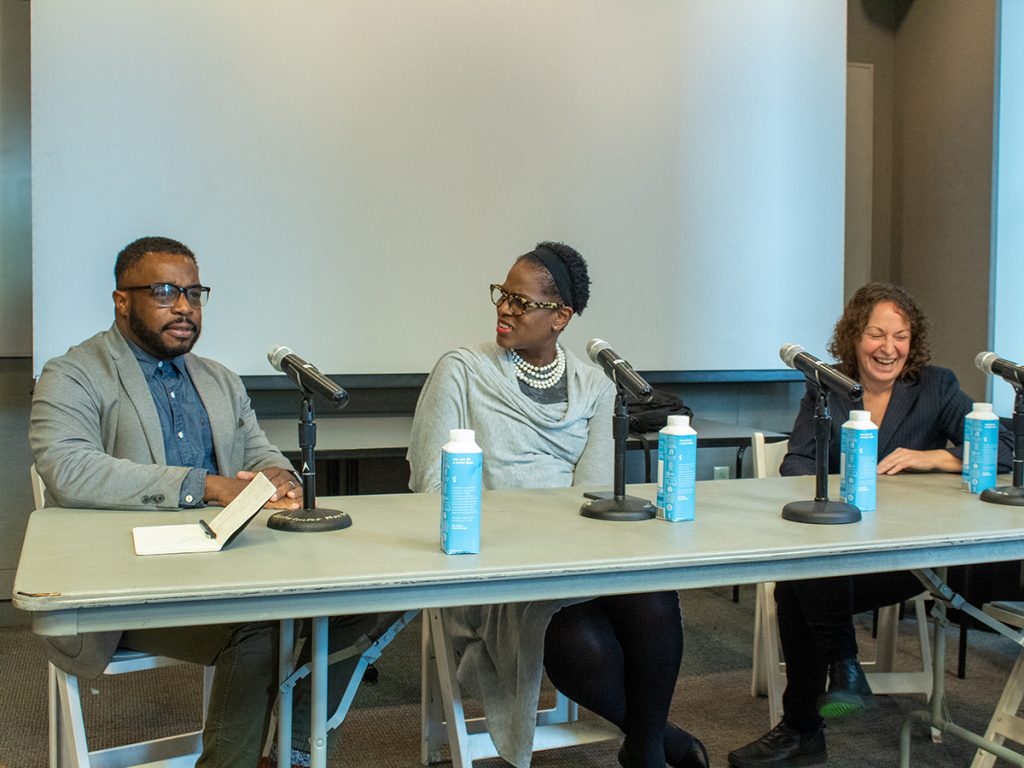The Business of Race with Ice Cream, Soda, and Sneakers

Ben & Jerry’s. Nike. Pepsi. Three mainstream businesses that approach race and social justice in their marketing campaigns in very different ways.
Those well-known and beloved American brands were highlighted at a Business of Race panel discussion as part of Emerson’s annual Teach-In on Race event series.
The panel was led by Executive-in-Residence Wes Jackson, Director of Business of Creative Enterprises (BCE), who was joined by Bithiah Carter, President of New England Blacks in Philanthropy, and Kristin Lieb, Associate Professor, Marketing Communication.
Lieb cut to the chase as to why businesses are reaching out to different demographics. “It’s bad business and stupid, financially, not to do so.” According to Nielsen, the African-American population spends $1.3 billion annually, said Lieb.
But businesses go about race and social justice in different ways, using data, hiring practices, development products, research, and marketing. Lieb contrasted the trio of businesses that depending upon how they approached the topic, came off as sincere, opportunistic, or hypocritical.
Ben & Jerry’s is fully committed to their approach, from whom they hire and where they get all of their brownies, to naming their ice cream flavors.
Nike approaches race and social justice in a hybrid kind of way – they tout diversity in their marketing campaigns, but have room to grow in things such as their hiring practices, Lieb said.
And Pepsi got slammed for shamelessly chasing trends in an opportunistic way, such as the infamous Kendall Jenner ad…
Ben & Jerry’s went on to release its Justice ReMix’d flavor. Lieb added that the company needed to have a serious and fun name for an ice cream flavor that dealt with race. And a business such as Ben & Jerry’s is going to involve people at all levels to come up with that marketing campaign for a social justice product.
Lieb has worked with Ben & Jerry’s for senior capstone projects at Emerson College, conceiving flavors to build awareness for criminal justice reform, which coincidentally, the business was also working on internally, “Students have built campaigns seen by Jerry himself.”
Race and social justice are also a huge component of the philanthropic world, said Carter, adding that nonprofit businesses represent 30 percent of the economy.
“He or she that controls the image controls the mind,” emphasized Carter. “I think there are images we’re very, very comfortable with in our society. You’re happy with me coming from an impoverished background, or me representing strength. You’re very comfortable with me representing an image that makes people feel like they’re doing right.”
Carter stressed that if a company wants to go after a market — say, China — you can’t just have a bunch of white men in the room coming up with the strategy. She said it’s really about getting people in the room who are the targeted demographic.
Jackson played devil’s advocate and asked why a company would decide to diversify its workforce, leadership, supply chain, and so forth, if they’re already making millions from the targeted demographic.
“From a competitive standpoint, there will be someone getting that money,” said Carter. “And that share of the pie will be smaller if you don’t engage smartly.”
Categories